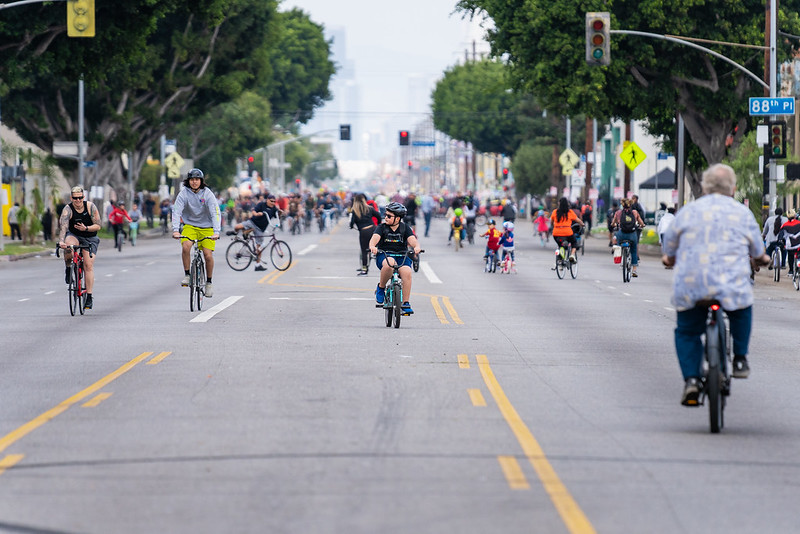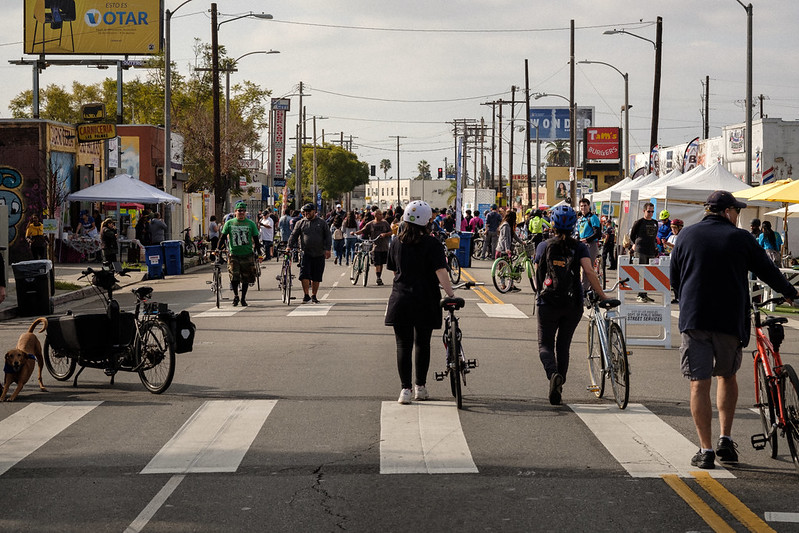10 min. read
Romel Pascual is Executive Director at CicLAvia, the largest open streets event in North America. He is an urban planner with a long history of championing environmental causes and social justice issues. Prior to his current role, Romel served as Deputy Mayor for Energy and Environment for Los Angeles.
Could you introduce CicLAvia and talk about how you become involved in this initiative?
My involvement with CicLAvia began when I was working for the former Mayor Antonio Villaraigosa at Los Angeles City Hall. The initial conversations about CicLAvia came from a group of individuals who had travelled to Bogotá, the place of the most epic open streets event in the world. Streets in the city centre of Bogotá are closed to traffic every Sunday, leaving a huge amount of inner-city, public space free for pedestrians, cyclists and so on, to use. They spoke about bringing a version of this to L.A.. It was 2009, the time of a significant recession and the economy was bad, the city budget was bad and it was not a good time for something new. I was unsure of what we could do but we agreed to meet and talk it over. We quickly decided that this was something we were going to do.
At the time I thought this would be a one-off event, and there’s no harm in that. We partnered with the city services to make it happen. It was quite the production and highly city personnel intensive, particularly as we had decided we would be making 8 miles of L.A. streets free of cars. With the weight of the Mayor’s support behind it, it didn’t matter so much that some of the department weren’t on board. He was the type of mayor that would always push us to do more, and never thought we were doing enough. There was boldness along with the mantra to make L.A. the greenest big city in America. In late 2009, the Mayor and I went to Copenhagen for a COP conference. It was December and we were driving through the city, and it was just full of bikes despite the cold. That was when the Mayor turned around and said ‘where is my CicLAvia?!’. He knew it would happen, but he wanted us to move faster. He knew that there was something potentially magical in it.
Fast forward to 2010, the first CicLAvia, and we realised what an appetite there was for it. So many people chose to attend. The first moment I stepped out onto the street, I simply thought, where are all these people coming from? You realise L.A. is big, there’s a lot of people, but people own bikes! It was quite an inspiring day on so many levels.
On the second CicLAvia, a few years later, I joined the board as an official member. We were looking for an executive director and, although I was part of the search committee and wasn’t a candidate, I was recognised as passionate and truly connected to the mission of CicLAvia. I made the decision to say yes. I was driven by the potential of what CicLAvia could become, by the opportunity of it having such a powerful impact many communities. To this day, we’ve done 35 great events.
What has been the impact of CicLAvia?
You can see the facts and figures of the impact CicLAvia has had, but there are other things that aren’t so tangible. There’s this sense of ‘joy with a purpose’ – the purpose of making wellbeing a human right, just as much as clean air, clean water, safe housing and a liveable wage. We don’t emphasise those intangibilities enough: equity, inclusion, diversity, wellbeing. The UN report on happiness captures some of these intangibilities and is just simplistically smart. Joy and wellness mean so many different things to different people and that’s what you can observe at CicLAvia which opens the street for no single agenda.
Equality was always something we felt was a benefit of it, but is not something we measured until later down the road. We also weren’t going into it as a climate strategy, although it ended up becoming part of our climate strategy. The metrics around air quality are pretty significant. UCLA conducted a study that showed an improvement in air quality of around 50% on the day of the event. It is clear: you take cars off the road and there are fewer emissions. I used to work for the Environmental Protection Agency so I have an environmental background. I’m aware of the environmental injustices associated with the ways in which air pollution has no boundaries, but its disproportionate impact on certain communities has a racial and class dynamic. CicLAvia also helps you understand that we are all individuals with a certain carbon footprint and that closing the streets to cars reminds us how much good air quality could benefit us all.
Ultimately it ended up being so many different pieces of metric. It was a metric for how we encourage active forms of transportation, a metric for air quality and climate resilience, a metric for what sustainability could look like. It became something 3D that could be applied to different levels of policy being pushed forward, like a sustainability plan, or for the advocacy for more bikes, parks and open spaces. CicLAvia became the poster for many different elements. You don’t know how something like this will resonate with so many different issues but it does. I think that when you have the openness of people choosing to partake in something like this, you also have an audience of people open to thinking about what the city can be.
In relation to what it can offer in the future, as we come out of the pandemic, I think CicLAvia can offer a restoration of social confidence and what I’m calling responsible social conscience. We will be out there on the streets giving people the opportunity to engage with it in whatever way they wish. We provide that canvas they can paint with whatever it is that will inspire them that day, the day after CicLAvia, and beyond.

CicLAvia has remained broad in its agenda, and refrained from labelling its purpose. How have people come to interpret CicLAvia?
You realise that people’s interpretations of CicLAvia are very similar. You see people out there doing the same thing and absorbing the atmosphere. The most eye opening thing for me is how CicLAvia becomes an equaliser of sorts. People connect and engage no matter their income level for example. It highlights how we have more in common than what divides us. We are advocating choice in the way we move and we want to introduce you to that.
We’re out there as an organisation with a set of principles and purpose. The purpose is to ensure you can reimagine your view of the city, whether that be of different communities, or reimagining your own position in the city. After CicLAvia Sunday, when you go back to your work week and start to drive again, you do notice things like bike lanes that you didn’t notice before. You open up a bit instead of missing everything in between your destination points. CicLAvia encourages you to look side to side, and to slow down a bit. People tell us about what they have discovered since the event, like a new cafe or different architecture. The word discover is interesting to me, as these things always existed, people always lived there. But what we do is open up different levels of opportunities to visit and experience things that otherwise you would not have done.
When on the topic of promoting active travel, the mantra is often ‘build it, they will come’ – a focus on the provision of physical infrastructure. What roles do open street events like CicLAvia play in promoting a culture of active mobility?
The promotion of active travel is a chicken and egg situation between providing hard infrastructure and soft infrastructure. On a different theme, take electric vehicles as an example: do you provide the charging stations first or the vehicles that will demand those stations? Really, you need some level of good policy that supports both. If good policy goes together with incentives (such as a rebate if you adopt this technology), then you open up people’s ability to be part of change in transportation. All of these elements must come together – good policy, good incentives, policy makers highlighting air quality issues, manufacturers recognising these changes. You have to think about leadership to push it, the policy that will support it and the company innovation that will infuse those jobs – it has to be brought together deliberately.
I think that with cycling, a lot of this can apply. We tend to look at those places that have that cycling culture such as the ‘natural cities’ of Copenhagen or Amsterdam. We don’t appreciate or understand that they had a history of struggle in reaching that end point. Getting to that point was really a cultural shift. For example, bike safety education needs to go into a curriculum so that the kids grow up knowing this is an option, and that it’s not a one off bike lane that we build but a comprehensive alternative mode of transport. Once we get away from the novelty of a protected bike lane, I think we infer the importance of traffic safety and bike safety into an education system. We need to give kids the opportunity to be inspired by a cycling culture or even a career in the cycling sector.
I think for us, that level of social identification and social drive that makes us aware that other people cycle and that there is infrastructure available to us is equally as important as ‘build the bike lane’. We will always have opposition to removing car lanes. People will always complain of the inconvenience it could cause to their car journey.
There’s interesting psychology about bikes. In L.A., you ride a bike as you don’t have a car. There’s an income and class dynamic associated with it. It’s interesting to see those with high end bikes riding purely for recreation as you know they would also own cars. Once we make bikes as a universal and appropriate form of transportation, and not as ‘riding a bike as you don’t have a car’, we can progress. There should be work around being proud of riding your bike – it’s an accomplishment as you have integrated exercise in your daily routine.

What learnings can we take from the experience of CicLAvia, and other open streets initiatives as we work towards achieving better air quality in our cities?
In L.A., and in Southern California more broadly, poor air quality has been the thing that has really defined the region. It’s traditionally been known as the city of two things: sprawl and smog. Growing up in the eighties, you could literally feel the air pollution in your lungs. I remember playing outside as a kid, you would have a hard time breathing. Of course that didn’t stop you, you were a kid at the end of the day. Overtime, regulations improved around mobile sources. The NOX and SOX associated with the creation of smog was at a point of being so unhealthy that a lot of the improvement of our air quality is because of technological improvements spurred on by the regulations.
The city of L.A. is approximately 500 square miles. When you look at its carbon footprint, over 50% is transportation related. What do you do to address that? Personal choices and people’s behaviour drastically helps improve our air quality, whether or not it’s a forced choice (like in the pandemic) or a personal choice. I remember being interviewed early on in the pandemic and the air was just crystal clear. You could see the mountains. Sure, part of it was to do with the climatic conditions that day – it was a little windy – but the visibility was consistently clear.
A lot of writers at the time spoke about air quality as a result of car-free streets. The pandemic lockdowns, as hard as they were, did show an environment that we hadn’t seen for a long time. I’m hoping that, having seen that transformation during the pandemic, the appreciation for the air quality we observed will be carried over. I think, once up and running again, CicLAvia can remind folks of what that felt like when you could see the mountains. CicLAvia does temporarily improve air quality, and I’m hoping in that sense it does affect personal choice and behaviour. That is part of the challenge and strategy for air quality improvement. It’s really about behavioural change just as much as behaviour change is part of our work to address climate change. We can mitigate as much as we can, but there’s a behavioural change element that we have the ability to really affect.

